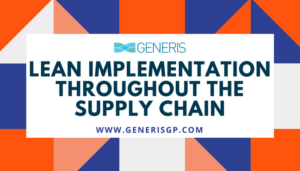 So you’ve been successful at implementing your own lean initiative, but now you’re being squeezed by your customers, who want lower prices and higher quality, and your shareholders who want higher profits. How do you satisfy both stakeholders?
So you’ve been successful at implementing your own lean initiative, but now you’re being squeezed by your customers, who want lower prices and higher quality, and your shareholders who want higher profits. How do you satisfy both stakeholders?
Generis thought leaders from Navistar, Under Armour, Toyota, the Lean Enterprise Institute, and Wabash Corporation share how they have worked with their suppliers to implement lean throughout the supply chain to decrease cost and improve product quality.
Benchmark
Michele Calbi, former VP, Lean Transformation at Navistar, says “you are only as good as your suppliers. If you can’t get parts delivered on time or the quality doesn’t meet your standards or the expectation of the customer, you’re just not going to be able to deliver what it is you expect.” She recommends using benchmarks like scorecards and reward programs so suppliers know where they’re at.
Consolidate
Phil Poel, VP, Manufacturing Excellence and PS&C at Under Armour, thinks along similar lines. He says, at Under Armour, they stress the operating philosophy: MPAGAYB (Make products as good as your brand). In order to do this, you need to make sure suppliers understand how good your brand is. If you can’t get them to do what you want, consider how you are engaging them. At Under Armour, rather than hedging their bets, they are now going “long and deep” with their vendors and have consolidated to just 37, mostly based in South East Asia. They have worked extensively with their consolidated supplier base to implement lean and quality values are now hitting 97% (compared with the industry average of 92%).
Treat Suppliers as Part of your Organization
Mark Reich, COO of the Lean Enterprise Institute explains, “When I was at Toyota in the Toyota Supplier Support Centre, we never looked at our suppliers, when it came to capability development, any differently than we looked at our own team members.” Joe da Rosa, also of Toyota (former President, Manufacturing, Toyota Motor Manufacturing, Texas) backs this up, saying, “In San Antonio, I had 23 on-site suppliers and we struggled with bridging the culture from the main plant to their buildings. So we had to actually go there and spend time, but I realized it was more effective if we brought their plant leadership to our plant, and have them go through all the training we go through and have them participate in our own activities. And once we felt that they had a good level of knowledge, they were the ones that had to take it back to their facilities. In order to cascade this kind of thinking, you’ve got to bring their leadership into it. They’ve got to buy into it, they’ve got to live it like you do and I’ve even allowed some of the key ones to attend my morning operations meeting.”
Segment based on Risk
Brent Yeagy, President & CEO of Wabash Corporation, acknowledges constraints that prevent complete supplier visibility. He says, “We start with the concept that we have scarce resources like every other company out there and so we can’t go everywhere. So it starts with a basic risk assessment, a multi-faceted risk assessment of where our supply chain sits. We also do an inventory of where our tier 1s sit in terms of their own resources, so we can help them deploy on our behalf and then we work that continuum. We can’t go everywhere so we try to go where we can move the needle to the greatest extent and do it with a purpose.”
To hear more insights from industry leaders in manufacturing and supply chain management, view these upcoming Generis Group events.